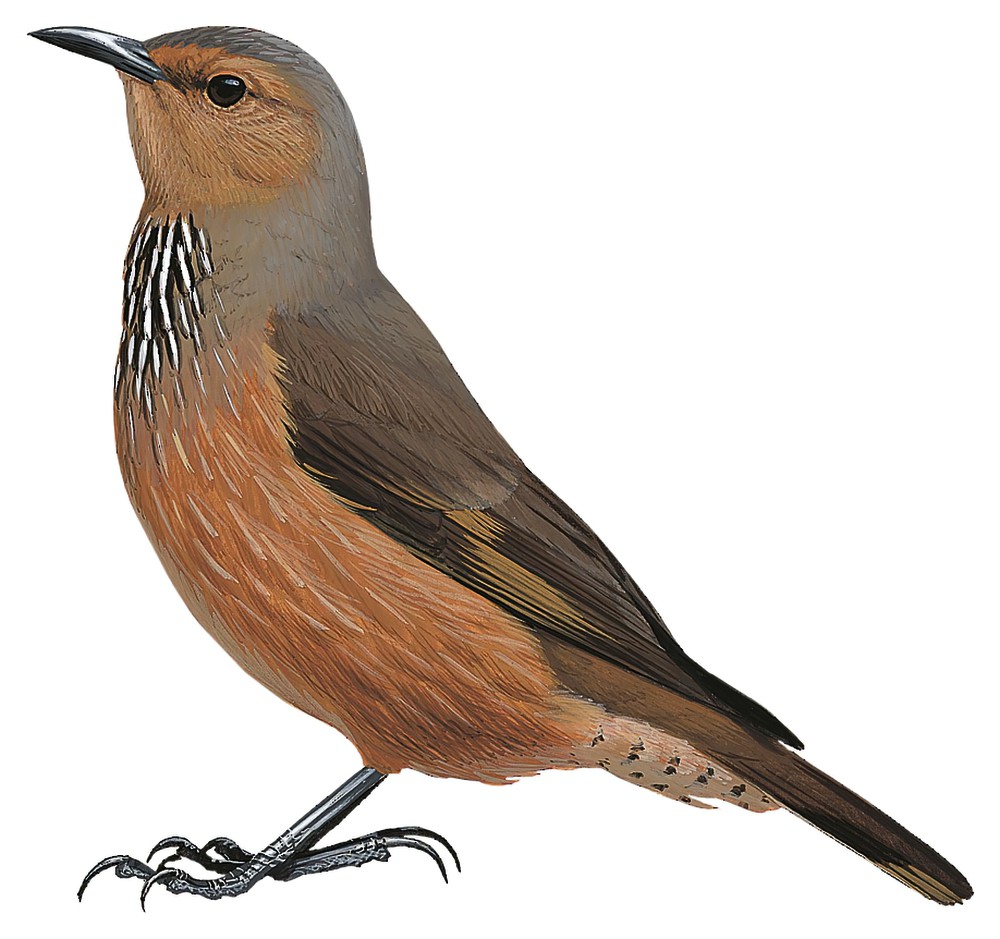Rufous Treecreeper / Climacteris rufus

Rufous Treecreeper
SCI Name:
Protonym: Climacteris rufa Proc.Zool.Soc.London(1840) (1840), Pt8 no.94 p.149
Taxonomy: Passeriformes / Climacteridae / Climacteris
Taxonomy Code: ruftre3
Type Locality: Western Australia.
Author: Gould
Publish Year: 1841
IUCN Status: Least Concern
DEFINITIONS
CLIMACTERIS
(Climacteridae; Ϯ Brown Treecreeper C. picumnus) Gr. κλιμακτηρ klimaktēr, κλιμακτηρος klimaktēros ladder; "12. ÉCHELET (1), Climacteris. (Temm.) — Caract. Bec court, faible, très-comprimé dans toute sa longueur, peu arqué, en alène; mandibules égales, pointues. Langue. Narines basales, latérales, couvertes par une membrane nue. Pieds forts; tarse de la longueur du doigt du milieu, celui-ci et le pouce extraordinairement longs; ongles très-grands et courbés, sillonnés sur les côtés, subulés, très-crochus; doigt extérieur réuni jusqu'à la seconde articulation; l'intérieur jusqu'à la première, latéraux très-inégaux. Ailes médiocres; 1re. rémige courte, la 2e. moins longue que la 3e., celle-ci et la 4e. les plus longues. Esp. Certhia scandens. — Certhia picumnus. (Illig.) ... (1) Les deux espèces connues sont de l'Océanique." (Temminck 1820); "Climacteris Temminck, 1820, Man. Orn., éd. 2, 1, p. 85. Type, by subsequent designation, Climacteris picumnus Temminck and Laugier (G. R. Gray, 1840, List Gen. Birds, ed. 1, p. 18)." (Greenway in Peters, 1967, XII, p. 162).
Synon. Climacterobates, Neoclima, Whitlocka.
rufum / rufus
L. rufus red, ruddy, rufous. In ornithology rufus, rufa and rufum cover a wide spectrum of colours from yellow, orange and brown to crimson, scarlet and purple.
● ex “Red-legg’d Partridge from Barbary” of Edwards 1743-1751 (syn. Alectoris rufa).
● ex “Crapaud-Volant” or “Tête-chêvre de Cayenne” of d’Aubenton 1765-1781, pl. 735, and “Engoulevent roux de Cayenne” of de Buffon 1770-1785 (Antrostomus).
● ex “Batara roxo” of de Azara 1802-1805, no. 218 (Casiornis).
● ex “Pic roux de Cayenne” of d’Aubenton 1765-1781, pl. 694, fig. 1, and “Rufous Woodpecker” of Latham 1782 (syn. Celeus undatus).
● ex “Coucal Rufin” of Levaillant 1807, pl. 221 (syn. Centropus benghalensis).
● ex “Fournier des Buenos Ayres” of d’Aubenton 1765-1781, pl. 739, “Fournier” of de Buffon 1770-1783, and “Rufous Bee-eater” of Latham 1782 (Furnarius).
● ex “Gobe-mouche roux de Cayenne” (= ♀) of d’Aubenton 1765-1781, pl. 453, fig. 1 (Pachyramphus).
● ex “Merle roux de Cayenne” (= ♀) of d’Aubenton 1765-1781, pl. 644, fig. 1 (syn. Percnostola rufifrons).
● “I cannot see the slightest advantage to be gained by rejecting Bechstein’s name for the Chiffchaff on the ground that Boddaert’s Sylvia rufa may be the Whitethroat. It is obvious that Boddaert intended to designate a bird other than the Whitethroat by this name; and under no circumstances can the name of Phylloscopus rufa, Bechst., be confounded with any other bird than the one to which he applied it” (Seebohm 1881); “Bechstein’s name, used by both Seebohm and Saunders, and also in the 1st edition [1883] of the List, really dates from his Gem. naturg. Deutsch. iv. 1795, p. 682, and is not an original description, but is founded on Gmelin’s Motacilla rufa. This is not a Phylloscopus, and the name cannot be used for the Chiffchaff” (BOU 1915) (syn. Phylloscopus collybita).
● ex “Caracterizado cañela corona de pizarra” (= ♀) of de Azara 1802-1805, no. 208 (Platypsaris).
● ex “Courly brun de l’isle de Luçon” of Sonnerat 1776 (syn. Plegadis falcinellus).
● ex “Ruff-necked Humming-bird” of Latham 1782, and “Ruffed Honey-sucker” of Pennant 1785 (Selasphorus).
● ex “Tangaroux de Cayenne” (= ♀) of d’Aubenton 1765-1781, pl. 711 (Tachyphonus).
● "95. TURDUS. ... rufus. 6. T. ferrugineus subtus dilutior maculatus, remigibus unicoloribus, cauda rotundata. Turdus ruffus [sic]. Catesb. car. I. p. 28. t. 28. Habitat in America septentrionali & meridionali." (Linnaeus 1758) (Toxostoma).
● ex “Yellow-belly’d Green Cuckow” of Edwards 1758, “Couroucou à queue rousse de Cayenne” of d’Aubenton 1765-1781, pl. 736, and “Rufous Curucui” of Latham 1782 (Trogon).
UPPERCASE: current genus
Uppercase first letter: generic synonym
● and ● See: generic homonyms
lowercase: species and subspecies
●: early names, variants, mispellings
‡: extinct
†: type species
Gr.: ancient Greek
L.: Latin
<: derived from
syn: synonym of
/: separates historical and modern geographic names
ex: based on
TL: type locality
OD: original diagnosis (genus) or original description (species)












